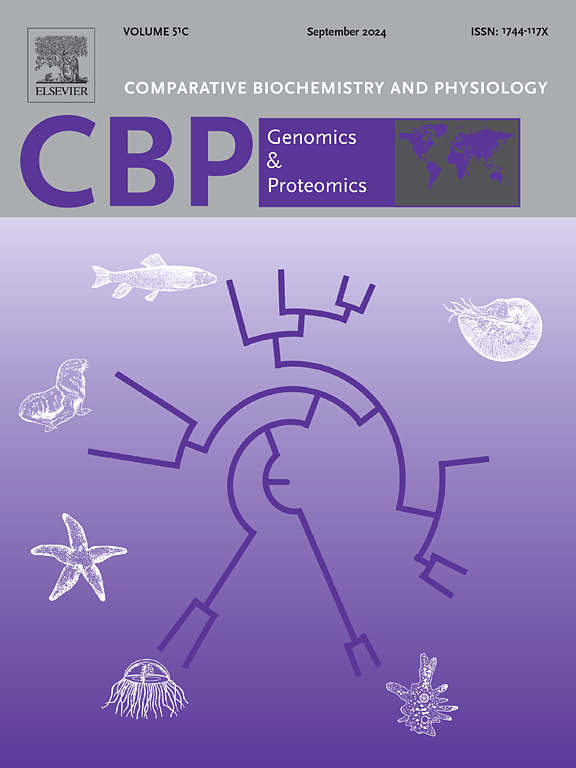高蛋白饲料对稻花鲤幼鱼和幼鱼生长、游离氨基酸代谢和蛋白质代谢相关基因的影响
IF 2.2
2区 生物学
Q4 BIOCHEMISTRY & MOLECULAR BIOLOGY
Comparative Biochemistry and Physiology D-Genomics & Proteomics
Pub Date : 2024-10-18
DOI:10.1016/j.cbd.2024.101345
引用次数: 0
摘要
膳食蛋白质对鱼类的影响已被广泛研究。然而,高蛋白日粮对梅氏原鲤生长和氨基酸代谢的影响及其机制仍不清楚。本研究探讨了日粮蛋白质水平(38%、44%、50%)对梅花鱼幼体和幼鱼生长性能和氨基酸含量的影响。转录组测序被用来研究梅花鱼对高蛋白食物的适应机制。结果表明,随着日粮蛋白质水平的增加,美罗鱼的最终体长、特定生长率和蛋白质效率比明显下降,而体内氨基酸含量则显著增加。此外,研究人员还获得了 370,513,858 个读数,并将其组装成 278,939 个平均长度为 559 bp 的单基因。KEGG 分析显示,差异表达基因主要涉及蛋白质消化吸收、碳水化合物消化吸收、淀粉和蔗糖代谢以及胰腺分泌。此外,高蛋白增加了参与胰蛋白酶(prss、ctrl、cca、ccb)、肽转运体(pept)、氨基酸转运体(b0at1)和糖元生成(g6pase)的基因的表达,这些基因可以消化吸收食物中的蛋白质,并将氨基酸转化为能量,从而适应高蛋白饮食。本文章由计算机程序翻译,如有差异,请以英文原文为准。

Effects of high-protein feeds on growth, free amino acid metabolism and protein metabolism-related genes in larvae and juveniles of rice flower carp (Procypris merus)
The effect of dietary protein on fish is widely studied. However, the high-protein diet effects and mechanisms on growth and amino acid metabolism in Procypris merus remain unclear. In this study, we investigated the effect of dietary protein levels (38 %, 44 %, 50 %) on the growth performance and amino acid contents in larvae and juveniles of P. merus. Transcriptome sequencing was used to study the adaptation mechanism of P. merus to a high-protein diet. The final length, specific growth rate, and protein efficiency ratio were remarkably decreased with increasing dietary protein levels, while the amino acid content of the body was significantly increased. In addition, 370,513,858 reads were obtained and assembled into 278,939 unigenes, with an average length of 559 bp. KEGG analysis revealed that differentially expressed genes were mainly involved in protein digestion and absorption, carbohydrate digestion and absorption, starch and sucrose metabolism, and pancreatic secretion. Moreover, high-protein increased the expression of genes involved in trypsin (prss, ctrl, cpa, cpb), peptide transporter (pept), amino acid transporter (b0at1), and gluconeogenesis (g6pase), which could digest and absorb the dietary protein, and converse amino acids into energy, resulting in adaption to a high-protein diet.
求助全文
通过发布文献求助,成功后即可免费获取论文全文。
去求助
来源期刊
CiteScore
5.10
自引率
3.30%
发文量
69
审稿时长
33 days
期刊介绍:
Comparative Biochemistry & Physiology (CBP) publishes papers in comparative, environmental and evolutionary physiology.
Part D: Genomics and Proteomics (CBPD), focuses on “omics” approaches to physiology, including comparative and functional genomics, metagenomics, transcriptomics, proteomics, metabolomics, and lipidomics. Most studies employ “omics” and/or system biology to test specific hypotheses about molecular and biochemical mechanisms underlying physiological responses to the environment. We encourage papers that address fundamental questions in comparative physiology and biochemistry rather than studies with a focus that is purely technical, methodological or descriptive in nature.

 求助内容:
求助内容: 应助结果提醒方式:
应助结果提醒方式:


